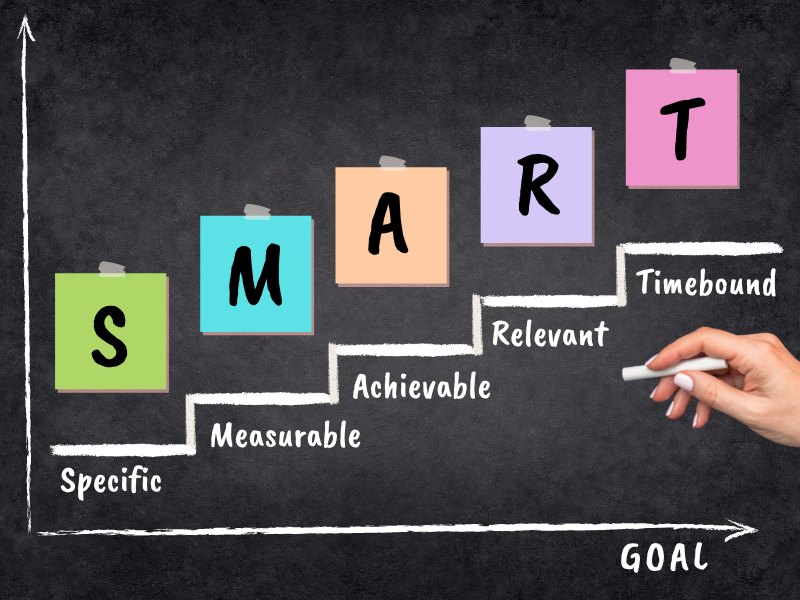- Home
- How to Create a Plan
How To Create A Plan: A Step-by-Step Guide For Success!
Knowing how to create a plan
is essential to reach any goal. Whether you’re planning
for personal growth, to meet business objectives, or anything in between, with
a clear roadmap in place, you'll be much more likely to succeed!
In this guide, I'll walk you through my tried-and-tested planning process, together with a practical example and printable templates to help you plan and successfully achieve your goals.
So, let's get started!
Contents:
- What are the benefits of planning?
- How to Create an Effective Plan
- Taking Action
- Making Adjustments
- Bottom Line
- Related Articles
- References

What Are The Benefits Of
Planning?
Planning takes time and
energy, so why should we bother?
My experience as a project manager, a parent, and living life, in general, has taught me that it's definitely worthwhile investing the time and effort to plan ahead. If you’re not convinced, check out some of the benefits that I’ve outlined below:
- Clarity: Planning gives a clear picture of what you need to do to achieve your objective. This is essential for you to stay focused and on track whilst you work toward your goal.
- Increased productivity: A well-planned approach enables you to prioritize your work and allocate your time and energy effectively. This avoids wasting time and resources on tasks that are not important or relevant to achieving your goals.
- Reduced stress: When you have a plan in place, you can anticipate potential challenges and have contingency plans in place to deal with them. This helps you to stay in control and avoids stress and overwhelm.
- Accountability: Planning helps you set clear expectations and hold yourself accountable for achieving your goals. It also provides a framework for monitoring your progress and making adjustments as needed.
- Motivation: Creating a plan can be
motivating in itself, as it helps you visualize your goals and the steps you
need to take to achieve them.

How To Create A Plan That
Works
A plan gives you direction and helps you to achieve your goals.
But where do you begin?
In the following paragraphs, I will show you how to create a plan that's effective and tailored to your unique needs.
Let’s take redecorating the bedrooms of your house as an example of how to build a plan.
Step 1
– Define your objectives
When
deciding how to create a plan, the first step is to define your goals and
objectives. One of the best ways to do this is by using the goal-setting criteria that
originate from the S.M.A.R.T. acronym, which stands for: Specific, Measurable,
Achievable, Relevant, and Timebound (1).
Specific:
To increase the likelihood of success, goals should be specific. This means that all objectives should be clearly defined to ensure that everyone involved knows exactly what should be achieved.
In this case, the goal is to redecorate all of the bedrooms in your house, so we could rephrase it like this: Redecoration work in all bedrooms that includes repairing wall surface imperfections and painting the ceilings, walls, skirting boards, and doors.
Measurable:
While working toward any goal, it’s necessary to monitor progress to ensure that you stay on track.
In this case, given that several tasks need to be completed to achieve the objective, you could use the completion of the main milestone tasks to measure progress.
Achievable:
All goals should be achievable and realistic, otherwise, they are destined to fail!
To determine whether a goal is realistic or not, you should first create a preliminary outline for the plan. In this case, the plan could involve using a painting and decorating contractor to do the surface preparation and painting tasks, or you could consider doing the work yourself.
If you don’t have the time or the skills to do the redecoration work yourself, using a painting and decorating contractor would definitely be the more realistic option.
Relevant
Goals should be relevant to your overall objectives and personal circumstances. If not, you'll be unlikely to put in the effort required to achieve them.
Considering our particular example, if you’re about to start a new job, or there's a young child in the household, it may not be the right time to redecorate the bedrooms.
Timebound
For a plan to be effective, it must be timebound. This helps to measure progress and sets a clear timeframe for all parties involved.
In this case, you could set a preliminary timeframe
of one month to complete the redecoration work and refine it when more
information becomes available during the planning process.

Step 2 – Define the steps required to achieve
the goal
After you have clearly defined your goal, the next
task is to determine the steps required to achieve it. These steps should be
organized sequentially.
The main steps for the plan to carry out the redecoration work would be as follows:
- Obtain contact details for various painting and decorating contractors.
- Request quotations for the redecoration work.
- Analyze quotations received and determine whether they fit your budget and desired timeframe.
- Select the most suitable painting and decorating contractor.
- Place orders for the redecoration work to be carried out.
- Carry out the redecoration work.
- Review the completed redecoration work.
- Make payments.
Step
3 - Identify resources
The
next stage of the planning process is to identify the resources needed for each
of the steps required to achieve our goal.
In this specific case, the main resources required to carry out the redecoration work would be:
- Materials and tools: To fill cracks, correct imperfections in the wall surfaces, and to paint the ceilings walls, and doors.
- Labor: To prepare the wall surfaces and carry out the painting work.
- Money: Do you have sufficient savings to cover the full cost of redecorating the bedrooms or will you require a loan?
- Time: Someone will have to invest time to get quotations, place orders, coordinate tasks with workmen, move and protect furniture, clear up, and put everything back in place after the work has been completed. Do you have the time to carry out these tasks or will you need to get help?
For
our example, let's say that the painting and decorating contractors will
provide the required materials, tools, and labor. You and
your spouse will coordinate the redecoration work and finance it with your
savings.

Step
4 – Identify potential constraints
Constraints can limit progress
or even prevent you from achieving your goals. These include competing
priorities, limited resources, and external factors beyond your control. By
identifying these factors upfront, you can decide how to create a plan to
tackle them and maximize your chances of success.
For
this particular example, you should consider how the redecoration work will
affect your daily routine, and situations that could cause you to deviate from
your plan.
First, consider the adjustments you'll need to make to your normal routine while the work is being carried out:
- Where will you sleep while the bedrooms are being redecorated?
- Will you have to move the furniture out of the bedrooms while they are being painted?
- Where will you put the furniture removed from the bedrooms?
You should also consider potential challenges that may arise such as unforeseen costs, delays in receiving materials, additional time taken to complete the work, etc.
In this specific case, you may decide to temporarily store bedroom items and furniture in the living room and to stay in a hotel while the bedrooms are being decorated. You could also allow for a few extra days in the hotel as a contingency plan in case the work takes longer than expected.
Step 5
– Create an action plan
Creating a plan is an iterative process. Start with a clear definition of the
goal you'd like to achieve, then define the steps required to achieve it.
At this point, you should also include the steps required to adjust your daily routine while the work is being carried out and any contingencies you consider necessary.
Arrange the steps in your plan in order of priority and sequence. This will help you stay focused while you execute your plan.
Considering our particular example, the main steps for the bedroom redecoration plan would be as follows:
- Obtain contact details of various painting and decorating contractors.
- Request quotations for the work.
- Analyze quotations and determine whether they align with your budget and timeframe.
- Select a painting and decorating contractor and agree on dates for the redecoration work to be carried out.
- Make hotel reservations.
- Move furniture out of the bedrooms.
- Painting and decorating work.
- Inspect the completed redecoration work.
- Make payments.
- Clean up and relocate items removed from the bedrooms.
Step 6 – Create a timeline
Once you've determined the sequence for your
steps, create a timeline for achieving your goal. This will help you to measure
progress and stay on track.
To create a timeline for your goal, estimate the time it will take to carry out each of the steps in your plan, then set a timeframe to complete each step.
Check whether the total amount of time required to execute the plan fits in with your original estimate. If not, you may need to adjust the duration of each step or carry out certain steps in parallel.
Be realistic about how long each step will take and adjust your timeline as needed.
I’ve provided a goal timeline for our redecoration example, together
with a blank template that you can use to create your tailor-made plan. Click
on the image below to download the example and your FREE template.
Another useful way to represent a timeline is
on a Gantt Chart. This provides a clear visual representation of project tasks,
timelines, and dependencies and is commonly used in project management for
planning, scheduling, and monitoring.
I’ve illustrated our redecoration example on a simple Gantt chart and provided a PDF template that you can use for planning simple projects without the need for project management software.
Click on the image below to download the example and your FREE template.
Take Action And Evaluate
Progress
You’ve already learned how
to create a plan, now the next crucial step is to put it into action. Start
with the first task and systematically proceed through each subsequent task. It
is essential to regularly evaluate progress to ensure that each task aligns
with your predetermined timeline.
As you
accomplish each task, mark it as complete and take a moment to acknowledge
and celebrate your achievements along the way.
Considering our example, just before the planned start date for the painting and decorating work, it would be advisable to contact the contracting company to confirm whether they will be starting work on the agreed date.
Once the work has commenced, you should also check that progress is being made as planned.
Make Adjustments
It’s
important to remember that plans are not set in stone. As you progress towards
your goal, you may encounter unexpected challenges or opportunities that
require you to adjust your approach.
In our particular example, if the painting and decorating work is delayed, you may have to adjust your hotel reservations.
Don’t be afraid to make changes to your plan as needed. In fact, being flexible and adaptable is a key component of success.
BOTTOM
LINE
Creating an effective plan takes time and effort, but it’s not as difficult as it may seem!
Clearly define your goal and the steps required to achieve it, identify resources and potential challenges, then build your plan and timeline accordingly.
Once you get started, evaluate progress and adjust your plan if required.
Remember that the objective is not to stick to the plan at all costs, but to achieve success in the most effective way possible.
Good luck!
Related Articles
Are you planning for something specific? Check out these articles to discover how to create a plan:
- Organize Your Life and Make More Time for YOU!
- How to Plan a Party
- How to Prepare for Thanksgiving
- Planning for Christmas
References
Share this with others by clicking the icons below!






